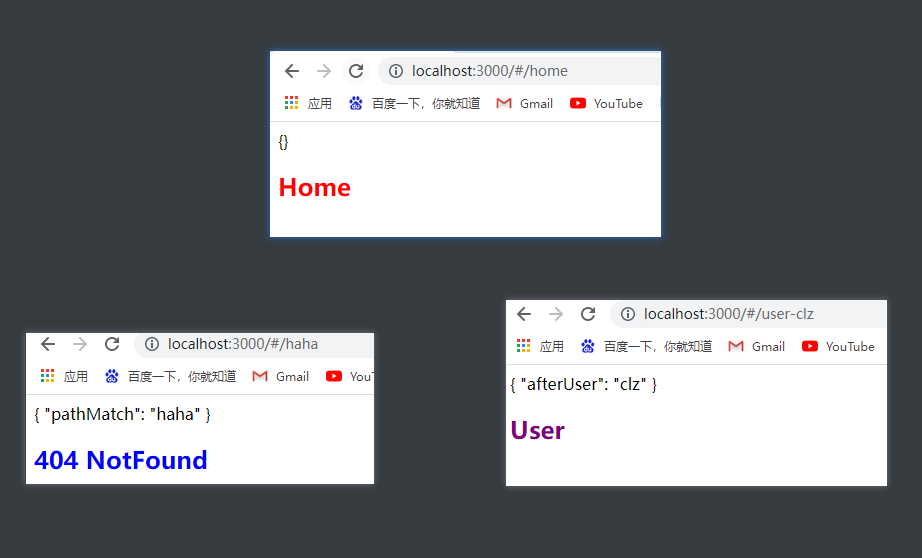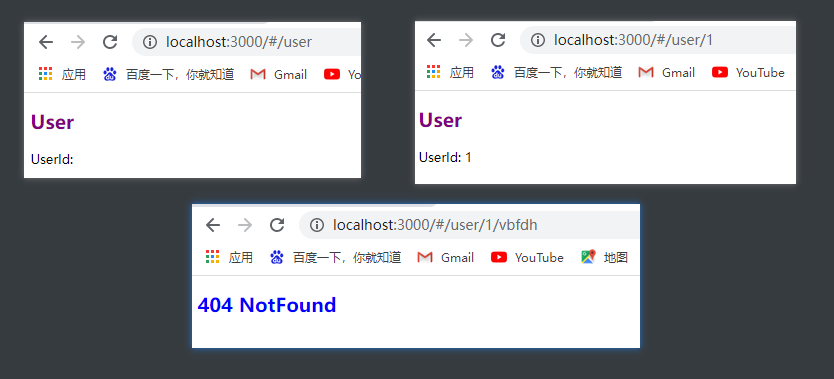Vue Router深入学习(一)
之前的笔记:Vue路由
通过阅读文档,自己写一些demo来加深自己的理解。(主要针对Vue3)
1. 动态路由匹配
1.1 捕获所有路由(404路由)
const routes = [ // 将匹配所有内容并将其放在 `$route.params.pathMatch` 下 { path: '/:pathMatch(.*)*', name: 'NotFound', component: NotFound }, // 将匹配以 `/user-` 开头的所有内容,并将其放在 `$route.params.afterUser` 下 { path: '/user-:afterUser(.*)', component: UserGeneric }, ]
使用:
import { createRouter, createWebHashHistory } from "vue-router"
const routes = [
{
path: '/',
redirect: '/home'
},
{
path: "/home",
name: "Home",
component: () => import("../components/Home.vue")
},
{
path: '/user-:afterUser(.*)',
// 将匹配以 `/user-` 开头的所有内容,并将其放在 `$route.params.afterUser` 下
name: 'User',
component: () => import('../components/User.vue')
},
{
path: "/:pathMatch(.*)*",
// 将匹配所有内容并将其放在 `$route.params.pathMatch` 下
name: 'NotFound',
component: () => import("../components/NotFound.vue")
}
]
const router = new createRouter({
history: createWebHashHistory(),
routes
})
export default router
app.vue
<template>
{{ route.params }}
<router-view></router-view>
</template>
<script setup>
import { useRoute } from 'vue-router'
const route = useRoute()
</script>

2 路由的匹配语法
主要是通过正则表达式的语法来实现
2.1 在参数中自定义正则
语法:
const routes = [ // /:orderId -> 仅匹配数字 { path: '/:orderId(\\d+)' }, // /:productName -> 匹配其他任何内容 { path: '/:productName' }, ]
实践:
路由配置:
import { createRouter, createWebHashHistory, useRoute } from "vue-router"
const routes = [
{
path: '/',
redirect: '/home'
},
{
path: "/home",
name: "Home",
component: () => import("../components/Home.vue")
},
{
path: "/user/:userid(\\d+)", // 两个\是因为会被转义
name: "UserId",
component: () => import('../components/UserId.vue')
},
{
path: '/user/:username',
name: "UserName",
component: () => import('../components/UserName.vue')
}
]
const router = new createRouter({
history: createWebHashHistory(),
routes
})
export default router

2.2 可重复的参数
可以使用*(0个或多个)和+(1个或多个)将参数标记为可重复
语法:
const routes = [ // /:chapters -> 匹配 /one, /one/two, /one/two/three, 等 { path: '/:chapters+' }, // /:chapters -> 匹配 /, /one, /one/two, /one/two/three, 等 { path: '/:chapters*' }, ]
实践:
*:
import { createRouter, createWebHashHistory, useRoute } from "vue-router"
const routes = [
{
path: "/:chapters*",
name: "Chapters",
component: () => import("../components/Chapters.vue")
}
]
const router = new createRouter({
history: createWebHashHistory(),
routes
})
export default router

+:

2.3 可选参数
使用 ? 修饰符(0 个或 1 个)将一个参数标记为可选
语法:
const routes = [ // 匹配 /users 和 /users/posva { path: '/users/:userId?' }, // 匹配 /users 和 /users/42 { path: '/users/:userId(\\d+)?' }, ]
实践:
const routes = [
{
path: '/user/:userid(\\d+)?',
name: 'User',
component: () => import('../components/User.vue')
},
{
path: '/:pathMatch(.*)*',
name: 'NotFound',
component: () => import('../components/NotFound.vue')
},
]

如果没加可选限制,那么访问/user时也会匹配到404去

3. 编程式导航
params 不能与 path 一起使用,而应该使用name(命名路由)
<template>
<router-view></router-view>
</template>
<script>
import { useRoute, useRouter } from "vue-router"
export default {
setup() {
const route = useRoute()
const router = useRouter()
// // query编程式导航传参
// router.push({
// path: "/user/123",
// query: {
// id: 666
// }
// })
// params编程式导航传参
router.push({
name: "user", // 需要使用命名路由
params: {
userid: 666
}
})
}
}
</script>
3.1 替换当前位置
不会向history添加新纪录,而是替换当前的记录
声明式:
<router-link to="/home" replace>home</router-link>
编程式:
router.replace({
path: '/home'
})
// 或
// router.push({
// path: '/home',
// replace: true
// })
4. 命名视图
需要同时同级展示多个视图,而不是嵌套展示时,命名视图就能够派上用场了
首先路由配置需要使用components配置
const routes = [
{
path: "/",
name: "home",
components: {
default: () => import("./views/First.vue"),
second: () => import("./views/Second.vue"),
third: () => import("./views/Third.vue")
}
}
];
使用router-view时,添加上name属性即可
<router-view></router-view>
<router-view name="second"></router-view>
<router-view name="third"></router-view>
示例:
5. 路由组件传参
首先可通过route来实现路由传参,不过也可以通过props配置来开启props传参
import { createRouter, createWebHistory } from "vue-router";
const routes = [
{
path: "/user/:id",
component: () => import("../components/User.vue"),
props: true
}
];
export default new createRouter({
history: createWebHistory(),
routes
});
通过props获取参数
<template>
<h2>User</h2>
<p>{{ id }}</p>
</template>
<script setup>
const props = defineProps(["id"]);
</script>
<style>
</style>

参考链接:Vue Router






















 395
395











 被折叠的 条评论
为什么被折叠?
被折叠的 条评论
为什么被折叠?








